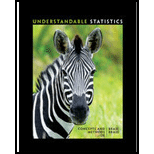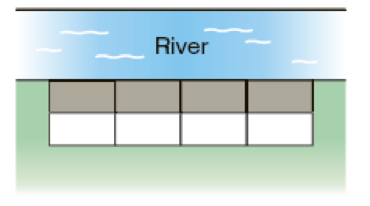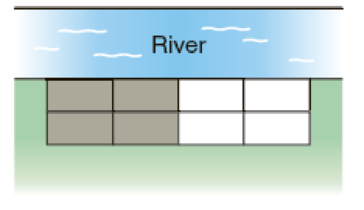
WebAssign Printed Access Card for Brase/Brase's Understandable Statistics: Concepts and Methods, 12th Edition, Single-Term
12th Edition
ISBN: 9781337652551
Author: Charles Henry Brase, Corrinne Pellillo Brase
Publisher: Cengage Learning
expand_more
expand_more
format_list_bulleted
Concept explainers
Textbook Question
Chapter 1.3, Problem 11P
Critical Thinking An agricultural study is comparing the harvest volume of two types of barley. The site for the experiment is bordered by a river. The field is divided into eight plots of approximately the same size. The experiment calls for the plots to be blocked into four plots per block. Then, two plots of each block will be randomly assigned to one of the two barley types.
Two blocking schemes are shown below, with one block indicated by the white region and the other by the gray region. Which blocking scheme, A or B, would be better? Explain.
Scheme A

Scheme B

Expert Solution & Answer
Trending nowThis is a popular solution!

Students have asked these similar questions
A small coffee shop sells freshly squeezed juices in a refrigerated unit with slots where juice is displayed. These slots are called facings. The manager of the coffee shop suspects that the distribution of juice sales is different than the distribution of facings for each type of juice, so the manager records the sales of each juice over a two-week period. The proportion of facings and the sales for each type of juice are shown in the tables.
Does the coffee shop owner have sufficient evidence to conclude that the distribution of sales is proportional to the number of facings at a 5 percent level of significance? Conduct the appropriate statistical test to support your conclusion.
To detect the presence of harmful insects in farm fields, we can put up boards covered with a sticky material and examine the insects trapped on the boards.
Which colors attract insects best?
Experimenters placed boards of several colors at random locations in a field of oats (four colors and six boards of each color).
Make a plot of the number of beetles trapped on each board against the board's color, arranging the colors to show blue first, then white, then green, and last yellow (space the four colors equally on the horizontal axis).
A biologist is studying the plant diversity in 15 million acres of the Sierra Nevada Mountains. He
will count the number of species in 150 acres. Match the strategies to their corresponding
sampling techniques.
The biologist goes to his 150 favorite hiking places and looks at an acres along
each trail.
v The biologist enters the 15 million acres into a data base and had a computer
randomly select 150 of these acres.
The biologist classifies the Sierras into 10 different ecological types and then
makes sure that the proportion of each ecological type from the sample is the same as
the proportion of that of the population.
The biologist orders the 15 million acres by latitude and then surveys every
100000th acre on the list.
| The biologist goes to 15 diverse locations that have 10 acres each and surveys
all 10 acres for each of these 15 locations.
a. Convenience Sampling
b. Cluster Sampling
c. Systematic Sampling
d. Stratified Sampling
e. Simple Random Sampling
Chapter 1 Solutions
WebAssign Printed Access Card for Brase/Brase's Understandable Statistics: Concepts and Methods, 12th Edition, Single-Term
Ch. 1.1 - Statistical Literacy In a statistical study what...Ch. 1.1 - Statistical Literacy Are data at the nominal level...Ch. 1.1 - Statistical Literacy What is the difference...Ch. 1.1 - Statistical Literacy For a set population, does a...Ch. 1.1 - Critical Thinking Numbers are often assigned to...Ch. 1.1 - Interpretation Lucy conducted a survey asking some...Ch. 1.1 - Marketing: Fast Food A national survey asked 1261...Ch. 1.1 - Advertising: Auto Mileage What is the average...Ch. 1.1 - Ecology: Wetlands Government agencies carefully...Ch. 1.1 - Archaeology: Ireland The archaeological site of...
Ch. 1.1 - Student Life: Levels of Measurement Categorize...Ch. 1.1 - Business: Levels of Measurement Categorize these...Ch. 1.1 - Fishing: Levels of Measurement Categorize these...Ch. 1.1 - Education: Teacher Evaluation If you were going to...Ch. 1.1 - Critical Thinking You are interested in the...Ch. 1.2 - Statistical Literacy Explain the difference...Ch. 1.2 - Statistical Literacy Explain the difference...Ch. 1.2 - Statistical Literacy Marcie conducted a study of...Ch. 1.2 - Statistical Literacy A random sample of students...Ch. 1.2 - Interpretation In a random sample of 50 students...Ch. 1.2 - Interpretation A campus performance series...Ch. 1.2 - Critical Thinking Greg took a random sample of...Ch. 1.2 - Critical Thinking Consider the students in your...Ch. 1.2 - Critical Thinking Suppose you are assigned the...Ch. 1.2 - Critical Thinking In each of the following...Ch. 1.2 - Sampling: Random Use a random-number table to...Ch. 1.2 - Prob. 12PCh. 1.2 - Sampling: Random Use a random-number table to...Ch. 1.2 - Prob. 14PCh. 1.2 - Computer Simulation: Roll of a Die A die is a cube...Ch. 1.2 - Education: Test Construction Professor Gill is...Ch. 1.2 - Education: Test Construction Professor Gill uses...Ch. 1.2 - Sampling Methods: Benefits Package An important...Ch. 1.2 - Sampling Methods: Health Care Modern Managed...Ch. 1.3 - Statistical Literacy A study of college graduates...Ch. 1.3 - Statistical Literacy Consider a completely...Ch. 1.3 - Critical Thinking A brief survey regarding...Ch. 1.3 - Critical Thinking A randomized block design was...Ch. 1.3 - Interpretation Zane is examining two studies...Ch. 1.3 - Interpretation Suppose you are looking at the 2006...Ch. 1.3 - Ecology: Gathering Data Which technique for...Ch. 1.3 - General: Gathering Data Which technique for...Ch. 1.3 - General: Completely Randomized Experiment How...Ch. 1.3 - Surveys: Manipulation The New York Times did a...Ch. 1.3 - Critical Thinking An agricultural study is...Ch. 1 - Critical Thinking Sudoku is a puzzle consisting of...Ch. 1 - Prob. 2CRPCh. 1 - Statistical Literacy You are conducting a study of...Ch. 1 - Prob. 4CRPCh. 1 - Prob. 5CRPCh. 1 - General: Type of Sampling Categorize the type of...Ch. 1 - Prob. 7CRPCh. 1 - General: Experiment How would you use a completely...Ch. 1 - Prob. 11CRPCh. 1 - Prob. 2DHCh. 1 - Prob. 1LCCh. 1 - Discuss each of the following topics in class or...Ch. 1 - Prob. 1UTCh. 1 - Prob. 2UT
Knowledge Booster
Learn more about
Need a deep-dive on the concept behind this application? Look no further. Learn more about this topic, statistics and related others by exploring similar questions and additional content below.Similar questions
- A number generator was used to simulate the percentage of people in a town who ride a bike. The process simulates randomly selecting 100 people from the town and was repeated 20 times. The percentage of people who ride a bike is shown in the dot plot. 10 20 30 40 50 60 70 80 90 100 Which statement is true about the population of the town? O Most likely, 50% to 60% of the town rides a bike. O Most likely, 60% to 75% of the town rides a bike. O Most likely, 40% to 50% of the town rides a bike. O Most likely, 80% to 90% of the town rides a bike.arrow_forwardSuppose automobile insurance companies gave annual premiums for top-rated companies in several states. The figure below shows box plots for the annual premium for urban customers in three states. Insurance Premium (annual, urban) HCalifomie Pennaylvania Texasarrow_forwardQq5arrow_forward
- A plant biologist conducted an experiment to compare the yields of 4 varieties of peanuts (A, B, C, D). A plot of land was divided into 16 subplots (4 rows and 4 columns). The plant biologist uses the design shown in Table Q2. Table Q2 B = 29.0 C = 26.7 A = 23.1 B = 29.3 D = 25.1 D= 29.8 C = 29.0 A = 27.3 A =19.7 B = 21.7 D= 24.9 C = 29.0 A = 28.7 D= 20.1 C =17.4 B= 35.1 What is the most appropriate design for this problem? State the statistical model with the necessary assumptions and identify the terms. (a) (b) Is the design symmetric? Justify your answer. (c) Analyze these data with the appropriate conclusions. (Use a = 0.05).arrow_forwardA magazine published a study on the ammonia levels near the exit ramp of a highway tunnel. The data in the table below represent daily ammonia concentrations (in parts per million) on eight randomly selected days during the afternoon drive time. Complete parts a through c.arrow_forwardPLEASE ANSWER ALL PARTS OF THE QUESTION AND USE THE IMAGE FOR A GUIDE A biologist is studying the effect of fertilizer on a species of endangered plant in a specific area of land divided into 32 equal sized plots. (See diagram.) Plots numbered 1—16 are in deep shade from the trees for most of the day while periodic flooding occurs in the areas numbered 17—32. The biologist chooses 16 plots at random and applies organic fertilizer. The other plots receive non-organic fertilizer. At the end of the study period, the percentage increase in the number of this plant is measured in each plot and compared for each type of fertilizer. Is this an experiment? Briefly explain your answer. A biologist is studying the effect of fertilizer on a species of endangered plant in a specific area of land divided into 32 equal sized plots. (See diagram.) Plots numbered 1—16 are in deep shade from the trees for most of the day while periodic flooding occurs in the areas…arrow_forward
- Direction: Explain each study described in each scenario. (Sample Surveys Study, Experiment Study or Observational Study). Please answer only (Sample Surveys Study, Experiment Study or Observational Study) and please explain why. Thank you so much and God bless!arrow_forwardWhen conducting research, you take a portion of a larger group of participants and do the research with that smaller group. The larger group is referred to as a population and the smaller group selected from the population is referred to as answerarrow_forwardThe histogram below gives the length of service of members of the Department of Chemistry at a particular university. The classes, in years of service, are 0−−4.9, 5−−9.9, etc., and the vertical axis represents the number of faculty. (a) What percent of the department faculty have 25 or more years of service? (b) If a member of the department is chosen at random to serve on a university committee, what is the probability (in decimal form) that the chosen representitive will have between 5 and 35 years of service? (c) What is the probability the representative above will have less than 30 years of service given that the person has less than 35 years of service?arrow_forward
- What percentage of the blocks are red?arrow_forwardIn the picturearrow_forwardDetermine whether the study depicts an observational study or an experiment. A scientist was studying the effects of a new fertilizer on crop yield. She randomly assigned half of the plots on a farm to group one and the remaining plots to group two. On the plots in group one, the new fertilizer was used for a year. On the plots in group two, the old fertilizer was used. At the end of the year the average crop yield for the plots in group one was compared with the average crop yield for the plots in group two.arrow_forward
arrow_back_ios
SEE MORE QUESTIONS
arrow_forward_ios
Recommended textbooks for you
 Glencoe Algebra 1, Student Edition, 9780079039897...AlgebraISBN:9780079039897Author:CarterPublisher:McGraw Hill
Glencoe Algebra 1, Student Edition, 9780079039897...AlgebraISBN:9780079039897Author:CarterPublisher:McGraw Hill Holt Mcdougal Larson Pre-algebra: Student Edition...AlgebraISBN:9780547587776Author:HOLT MCDOUGALPublisher:HOLT MCDOUGAL
Holt Mcdougal Larson Pre-algebra: Student Edition...AlgebraISBN:9780547587776Author:HOLT MCDOUGALPublisher:HOLT MCDOUGAL Big Ideas Math A Bridge To Success Algebra 1: Stu...AlgebraISBN:9781680331141Author:HOUGHTON MIFFLIN HARCOURTPublisher:Houghton Mifflin Harcourt
Big Ideas Math A Bridge To Success Algebra 1: Stu...AlgebraISBN:9781680331141Author:HOUGHTON MIFFLIN HARCOURTPublisher:Houghton Mifflin Harcourt

Glencoe Algebra 1, Student Edition, 9780079039897...
Algebra
ISBN:9780079039897
Author:Carter
Publisher:McGraw Hill

Holt Mcdougal Larson Pre-algebra: Student Edition...
Algebra
ISBN:9780547587776
Author:HOLT MCDOUGAL
Publisher:HOLT MCDOUGAL

Big Ideas Math A Bridge To Success Algebra 1: Stu...
Algebra
ISBN:9781680331141
Author:HOUGHTON MIFFLIN HARCOURT
Publisher:Houghton Mifflin Harcourt
Statistics 4.1 Point Estimators; Author: Dr. Jack L. Jackson II;https://www.youtube.com/watch?v=2MrI0J8XCEE;License: Standard YouTube License, CC-BY
Statistics 101: Point Estimators; Author: Brandon Foltz;https://www.youtube.com/watch?v=4v41z3HwLaM;License: Standard YouTube License, CC-BY
Central limit theorem; Author: 365 Data Science;https://www.youtube.com/watch?v=b5xQmk9veZ4;License: Standard YouTube License, CC-BY
Point Estimate Definition & Example; Author: Prof. Essa;https://www.youtube.com/watch?v=OTVwtvQmSn0;License: Standard Youtube License
Point Estimation; Author: Vamsidhar Ambatipudi;https://www.youtube.com/watch?v=flqhlM2bZWc;License: Standard Youtube License